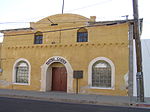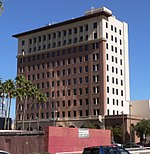Sosa–Carrillo–Fremont House

The house at 145–153 S Main St, Tucson, Arizona, officially listed in the National Register of Historic Places as the Sosa–Carrillo–Fremont House, is known locally for its association with John Charles Frémont, former Territorial Governor of Arizona. The house was originally listed on the National Register as the John Charles Fremont, Casa del Gobernador, House in 1971, but the official listing name was later changed to Sosa–Carrillo–Fremont House to better reflect the building's association with several important families in the region's history. The building is also known as the Carrillo House, the Leopoldo Carrillo House, and the Carrillo–Frémont House. The building is now owned by the Arizona Historical Society and is operated as a museum.
Excerpt from the Wikipedia article Sosa–Carrillo–Fremont House (License: CC BY-SA 3.0, Authors, Images).Sosa–Carrillo–Fremont House
West Ochoa Street, Tucson
Geographical coordinates (GPS) Address Nearby Places Show on map
Geographical coordinates (GPS)
| Latitude | Longitude |
|---|---|
| N 32.219444444444 ° | E -110.97361111111 ° |
Address
Tucson Convention Center
West Ochoa Street
85701 Tucson
Arizona, United States
Open on Google Maps










